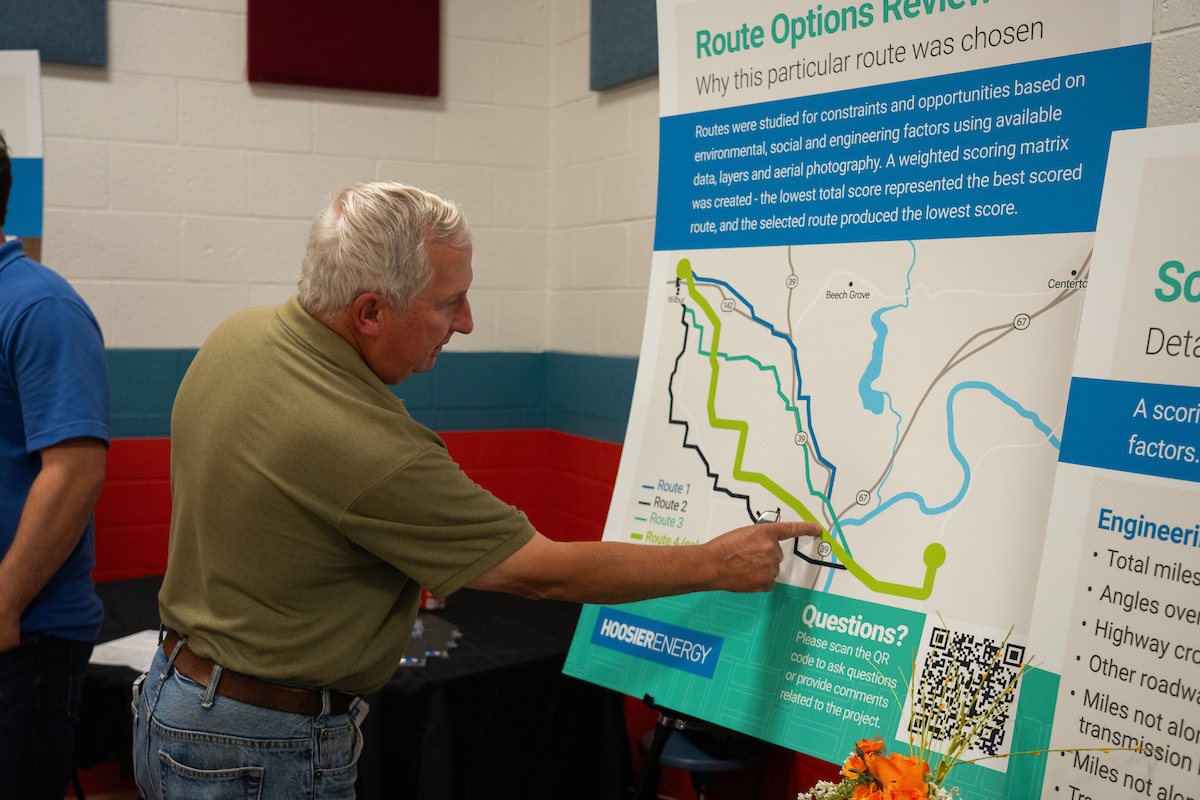Change is never easy.
It only gets more difficult when change is unwanted.
But in the case of Hoosier Energy’s Centerton to Wilbur Project, constructing 5.8 miles of new 69kV overhead transmission line is a necessity for South Central Indiana REMC members.
An open house at Centerton Elementary School on June 23-24 was one way Hoosier and SCI sought to convey the message.
“From our perspective, I thought it was a great opportunity for the community, for Hoosier Energy and for South Central Indiana REMC,” said Gregg Hopsicker, Vice President Distribution Services for SCI. “The open house brought in the project manager to discuss why we’re looking to do the project. It will give the Wilbur substation redundancy, making it more resilient and not just a single point of power. As the community grows, the project helps not only SCI but the members as well.”
Hoosier Energy Sr. Project Manager Amanda Sheehe agreed that the open house was important, even if there won’t be any evidence of change for another year when construction finally begins.

An SCI member looks at a map of the proposed Centerton to Wilbur transmission line project.
“I thought it was a positive thing to help show the community that we were open and wanted them to be informed,” said Sheehe. “The strong turnout shows the community is very tight-knit in the area. They were very invested and care about their neighbors, so they talked to their neighbors and got a lot of people to come.”
The goal of the project – connecting the Hoosier Energy Wilbur substation to the Duke Energy Centerton substation – is to provide another power source to feed the area, lessening the frequency and duration of power outages to SCI REMC members who receive power around the Wilbur, Monrovia and Mooresville areas while also supporting any future load growth in the area.
Still, the idea of power lines running through the yards, fields and forests of homeowners made for some uneasy feelings.
“I was at the open house and able to roam around, speak to a few members with concerns,” Hopskicker said. “I was able to direct them to the right people, which was primarily Shannon (Morrison).”
Morrison, a Hoosier Energy real estate specialist, was a focal point with a large TV monitor providing a Google Earth view of the properties with geographic information system (GIS) data overlayed to show the project route. He could even measure the distance from the proposed lines to owners’ homes, garages and barns.
“One of the things I said multiple times was if the project wasn’t warranted, we wouldn’t be doing it,” Morrison said. “We’re not looking to haphazardly spend capital dollars building infrastructure that’s not needed.
“I would zoom up to the substation and show them that right now there is only one tap line feeding that substation. If something happens on that line, everybody’s power that is fed from that substation goes away.”
SCI members can understand the importance of providing such reliability, especially in the wake of heavy storms and tornadoes this spring and summer.
“During storms, it can be challenging to redirect power and this will help us keep power to the substation,” Hopsicker said. “I think with the open house, there was an opportunity for members to understand and comprehend what the project is all about.”
It’s a project that is also about building trust, both with the members and between Hoosier Energy and South Central Indiana REMC.
“The open house felt like it was a success,” Sheehe said. “Seeing the buy-in from SCI and getting to meet more of their team. I have some rebuilds in their area also, so I’ve interacted with them on other projects. We’re working well together.”
Hopsicker agrees.
“Working with Amanda has been fantastic,” he said. “Anything we put out there, she listens to us. Having her on multiple projects makes the relationship easier instead of starting over with a new person. She’s very understanding and open, and it’s great to have a single point of contact. Things go smooth. It feels like there’s chemistry there.”
That chemistry is important when trying to make changes, especially when not everyone is ready to embrace change just yet.
“We’re grateful the project is going forward and will help us from a reliability standpoint,” Hopsicker said. “SCI is excited about the project and, in the end, the members will be excited about it, too.”